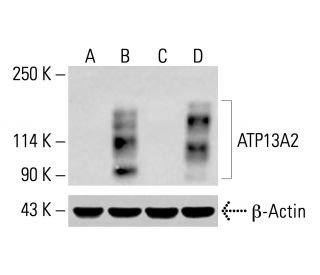



ATP13A2 Antibody (4B7): sc-293367. 未処理K-562(A)、化学処理K-562(B)、未処理HCT-116(C)および化学処理HCT-116(D)全細胞溶解液におけるATP13A2発現のウェスタンブロット解析。β-アクチン(C4):sc-47778をローディングコントロールとして使用。使用した検出試薬: m-IgG Fc BP-HRP: sc-525409.
ATP13A2抗体(4B7): sc-293367
- ATP13A2抗体 4B7はマウスモノクローナルIgG2aATP13A2 抗体 です。100 µg/mlで提供
- human由来のATP13A2のアミノ酸68-154に対応します
- mouse, rat と human 由来のATP13A2 WB, IP と ELISAでの検出にはお勧めします
- m-IgG Fc BP-HRPは、ATP13A2 Antibody (4B7) WBアプリケーション用。 用の二次検出試薬です。この試薬は現在、ATP13A2 Antibody (4B7) とセットで提供されています(下記の注文情報をご参照ください)。
クイックリンク
サポート品
説明
Gene情報
データシートとプロトコル
研究情報
ATP13A2 抗体 (4B7) は、マウス、ラット、およびヒト由来の ATP13A2 タンパク質をウェスタンブロッティング (WB)、免疫沈降 (IP)、および酵素免疫測定法 (ELISA) で検出する、マウスモノクローナル IgG2a κ軽鎖抗体です。 ATP13A2 (4B7) 抗体は、非結合型の抗 ATP13A2 モノクローナルアイソタイプ抗体としてもご利用いただけます。ATP13A2(ATPアーゼタイプ13A2、KRPPD、PARK9、またはHSA9947とも呼ばれる)は、細胞膜を横断する無機カチオンの輸送に不可欠なATPアーゼのP5サブファミリーに属する、1,180個のアミノ酸からなる重要な多回膜貫通タンパク質です。ATP13A2 は主にリソソーム膜に存在し、細胞内のイオン恒常性の維持や、マンガンや亜鉛などの金属イオンの輸送の調節に重要な役割を果たしています。ATP13A2の正常な機能は極めて重要です。なぜなら、ATP13A2の活性が阻害されると細胞内に有毒金属が蓄積し、早期発症の神経変性および認知症を特徴とするまれな遺伝性のパーキンソン病の一種であるクー・オル・ラケブ症候群を含む神経変性疾患の一因となる可能性があるからです。ATP13A2遺伝子は、ヒトゲノムの大部分を占めるヒト染色体1上に位置しており、3,000以上の遺伝子を含み、2億6,000万の塩基対にわたるこの染色体は、健康と疾患における遺伝子制御の複雑性と重要性を浮き彫りにしています。
試験・研究用以外には使用しないでください。 臨床及び体外診断には使用できません。
Alexa Fluor® はMolecular Probes Inc., OR., USAの商標です。
LI-COR® and Odyssey® はLI-COR Biosciencesの登録商標です。
ATP13A2抗体(4B7) 参考文献:
- Kufor-Rakeb症候群は, 核上性斜視麻痺と痴呆を伴う錐体神経変性症で, 1p36にマップされる。 | Hampshire, DJ., et al. 2001. J Med Genet. 38: 680-2. PMID: 11584046
- マウスにおけるP型輸送ATPアーゼのP5サブファミリーの特性解析。 | Schultheis, PJ., et al. 2004. Biochem Biophys Res Commun. 323: 731-8. PMID: 15381061
- 遺伝性痴呆性パーキンソニズムは, ライソゾーム型5型P型ATPaseをコードするATP13A2の変異によって引き起こされる。 | Ramirez, A., et al. 2006. Nat Genet. 38: 1184-91. PMID: 16964263
- 若年性パーキンソン病および若年発症パーキンソン病におけるATP13A2ミスセンス変異。 | Di Fonzo, A., et al. 2007. Neurology. 68: 1557-62. PMID: 17485642
- 東アジアにおけるPARK9連鎖性パーキンソニズム:ATP13A2の変異検出と臨床表現型。 | Ning, YP., et al. 2008. Neurology. 70: 1491-3. PMID: 18413573
- 台湾とシンガポールにおけるパーキンソン病と関連する新規ATP13A2変異体。 | Lin, CH., et al. 2008. Neurology. 71: 1727-32. PMID: 19015489
- パーキンソン病におけるATP13A2の変動性。 | Vilariño-Güell, C., et al. 2009. Hum Mutat. 30: 406-10. PMID: 19085912
- 遅発性パーキンソン病におけるP型ATPアーゼATP13A2の遺伝的関連研究。 | Rakovic, A., et al. 2009. Mov Disord. 24: 429-33. PMID: 19097176
注文情報
| 製品名 | カタログ # | 単位 | 価格 | 数量 | お気に入り | |
ATP13A2 抗体 (4B7) | sc-293367 | 100 µg/ml | $316.00 | |||
ATP13A2 (4B7): m-IgG Fc BP-HRP Bundle | sc-552001 | 100 µg Ab; 10 µg BP | $354.00 |
